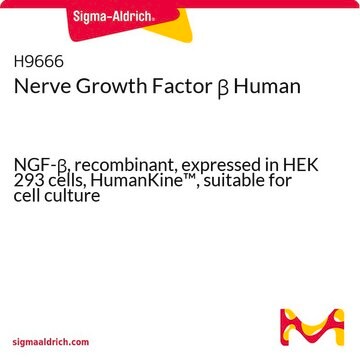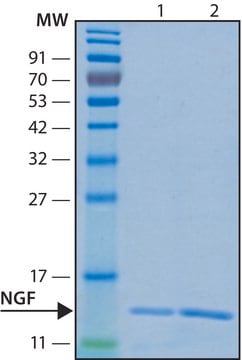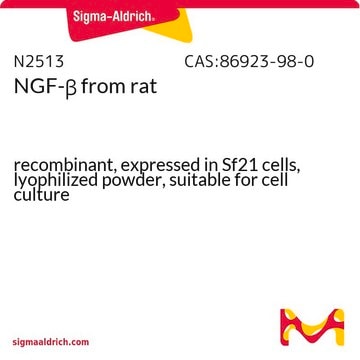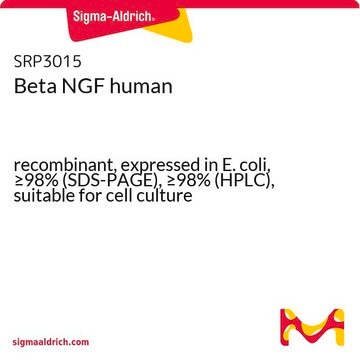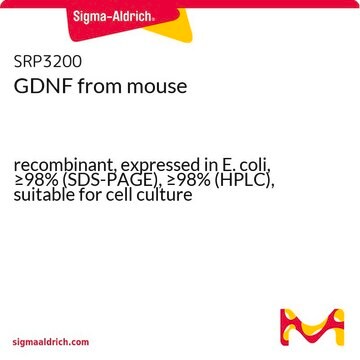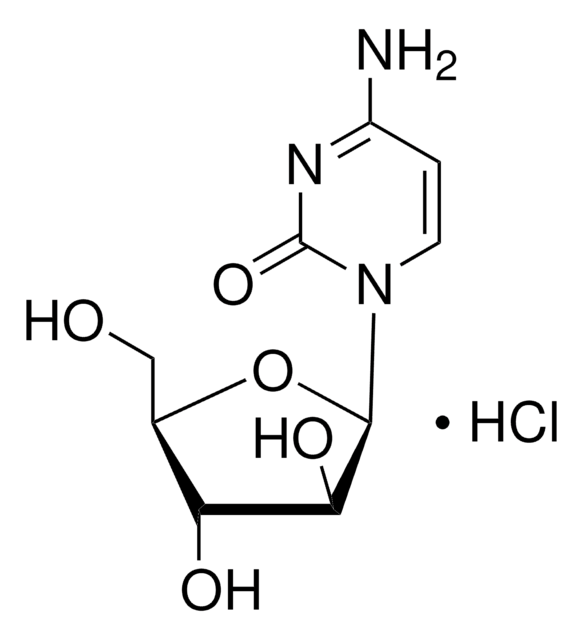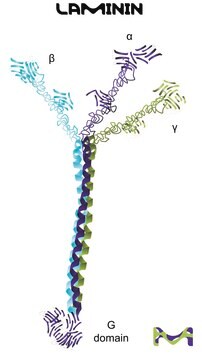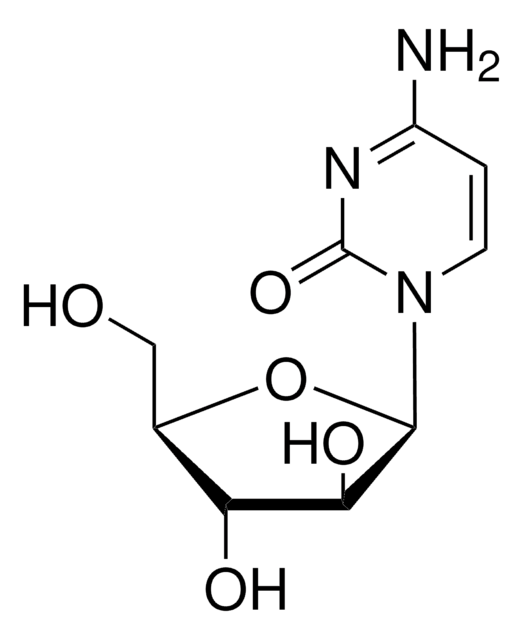추천 제품
제품명
Nerve Growth Factor-2.5S from murine submaxillary gland, NGF-2.5S, lyophilized powder, suitable for cell culture
생물학적 소스
mouse
Quality Level
양식
lyophilized powder
효능
0.1-30 ng/mL EC50 (using PC-12 cells)
분자량
26.5 kDa
포장
pkg of 4X25 μg
저장 조건
avoid repeated freeze/thaw cycles
기술
cell culture | mammalian: suitable
UniProt 수납 번호
배송 상태
dry ice
저장 온도
−20°C
유전자 정보
mouse ... Ngf(18049)
일반 설명
Nerve growth factor (NGF) is produced by different cell types: structural, accessory, and immune cells. It belongs to the neurotrophin family of trophic factors.
애플리케이션
Nerve Growth Factor-2.5S from murine submaxillary gland has been used:
- in Ham′s F-12 medium for performing growth cone collapse assay using dorsal root ganglions (DRGs)
- as a media supplement in the “process compartment” for microfluidic chamber studies
- to treat mid-luteal cells to study its effect on choline acetyltransferase (CHAT) expression
생화학적/생리학적 작용
Nerve growth factor (NGF) is neurotrophic and maintains sympathetic and sensory neurons of the peripheral nervous system and forebrain cholinergic neurons. NGF promotes the development of neurite-like filaments from chick embryo dorsal root ganglia and rat PC12 pheochromocytoma cells. NGF may have a role in in vivo fetal development and nerve regeneration especially, after ischemic, surgical, or chemical injuries. NGF may also be associated with the central nervous system. It exhibits ameliorating effects against ulcers (human cutaneous, corneal ulcers, and pressure ulcers), glaucoma, maculopathy, and retinitis pigmentosa. NGF-2.5S is a type of NGF-b originally derived under dissociative conditions and often varies from NGF-b due to proteolysis arising during its purification.
기타 정보
2.5S subunit of nerve growth factor-7S (NGF-7S) is essentially the β-subunit when isolated from male mouse submaxillary glands under initially dissociative conditions by a modification of the method of Bocchini and Angeletti.
물리적 형태
Lyophilized from a 0.2 μm filtered solution in sodium acetate buffer.
분석 메모
The biological activity is measured using a 3-day MTT assay.
Storage Class Code
11 - Combustible Solids
WGK
WGK 3
Flash Point (°F)
Not applicable
Flash Point (°C)
Not applicable
개인 보호 장비
Eyeshields, Gloves, type N95 (US)
Nessma Sultan et al.
Neural regeneration research, 16(9), 1821-1828 (2021-01-30)
Dental pulp stem cells (DPSCs) secrete neurotrophic factors which may play an important therapeutic role in neural development, maintenance and repair. To test this hypothesis, DPSCs-conditioned medium (DPSCs-CM) was collected from 72 hours serum-free DPSCs cultures. The impact of DPSCs-derived
Hongyue Dai et al.
FASEB bioAdvances, 4(1), 76-89 (2022-01-14)
Tumor innervation has recently been documented and characterized in various settings and tumor types. However, the role that nerves innervating tumors play in the pathogenesis of cancer has not been clarified. In this study, we searched for neural signaling from
Haeman Jang et al.
Proceedings of the National Academy of Sciences of the United States of America, 106(33), 14063-14068 (2009-08-12)
One of the greatest influenza pandemic threats at this time is posed by the highly pathogenic H5N1 avian influenza viruses. To date, 61% of the 433 known human cases of H5N1 infection have proved fatal. Animals infected by H5N1 viruses
Antonio Merolli et al.
Journal of anatomy, 240(5), 998-1001 (2021-11-24)
Fluorescent markers, generally targeting neurotubules, are used to visualize the radiating crown of growing neurites that is produced by dorsal root ganglion cells in vitro. Hoechst 33342 (2'-[4-ethoxyphenyl]-5-[4-methyl-1-piperazinyl]-2,5'-bi-1H-benzimidazole trihydrochloride trihydrate) is a widely used fluorescent DNA marker that stain both
Hidetada Matsuoka et al.
The journal of histochemistry and cytochemistry : official journal of the Histochemistry Society, 68(10), 679-690 (2020-09-05)
TWIK-related acid-sensitive K+ (TASK) homomeric channels, TASK1 and TASK3, are present in PC12 cells. The channels do not heteromerize due plausibly to a lack of p11 protein. Single-channel recording reveals that most of the rat carotid body (CB) glomus cells
자사의 과학자팀은 생명 과학, 재료 과학, 화학 합성, 크로마토그래피, 분석 및 기타 많은 영역을 포함한 모든 과학 분야에 경험이 있습니다..
고객지원팀으로 연락바랍니다.
